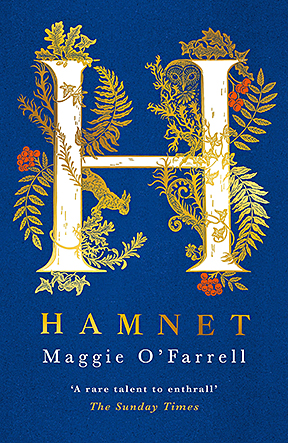Hamnet by Maggie O’Farrell
These days, it’s often the case a book will be written in first person and/or present tense. I’ve noted before I find this extremely off-putting unless the writer confines herself to one character living the events.  Why force me from one present tense POV to another, especially when moving from person to person in rapid succession? She walks down the road, looking for a place to sit. He sits in his kitchen eating cookies, watching a television program about elves. The other guy dances in a nightclub with a hot babe. Huh?
Why force me from one present tense POV to another, especially when moving from person to person in rapid succession? She walks down the road, looking for a place to sit. He sits in his kitchen eating cookies, watching a television program about elves. The other guy dances in a nightclub with a hot babe. Huh?
In this many-ways-stellar novel, the writer forces us to endure a present tense, and while for the most part, she focuses her attention on Agnes (more about that name later), she does hop around enough to make that present tense uncomfortable.
I will say that perhaps some of that discomfort is due to the fact that as I read, I am constructing a visual story in my mind. I see what the writer is telling me. As testament to that, I pictured the boy Hamnet of the title as a dark-haired child, only to discover when he dies in a latter chapter and his mother cuts a lock of his hair, that he was a summer blonde. O’Farrell never gave me a good chance, or any distance, to let me “see” things. She was jumping from liquid descriptions, going on and on and on, of what a character was experiencing internally, to smells of herbs – that perhaps I had never experienced before and which were not offered to me in a way that helped me – and fragmented sentences of many, many, many verbs.
It is, perhaps, the verbs that are most bothersome in many modern novels. When sentence after sentence contains multiple verbs, each in the present tense, you’ve set a mighty chore for a reader. I’m not suggesting two or three verbs in a long sentence, but six, seven, eight verbs. Which verb am I concentrating on? How do I picture this? What is the main character actually doing, as opposed to experiencing – and given that some verbs are observations and others are actions and others are feelings, what just happened?

Suffice to say, it was work to read. With novels, I prefer to coast.
I can’t fault “Hamnet” on at least some of these scores. The story itself had much to recommend it, given a few major problems. From the standpoint of research, O’Farrell did an excellent job. Her details of life in the late 1500’s were many, and to the extent that they were described, helped this reader with small things like baskets and floorboards and doors that opened top and bottom. Things usually detailed in romances and historic novels were frequently omitted, such as detailed descriptions of clothing and food. These omissions left me wanting more ways in which to imagine the action.
And the concept of a romance set in the late 1500s in a small English town would naturally be something that would intrigue me. I love historic fiction, as a rule.
But the larger issue for me was that the writer chose, for reasons I still don’t clearly understand, to play with the details of what is, for many people, well-known: the lore of William Shakespeare. Now, granted, not everyone knows the name of the woman he married, or that he married her when she was already pregnant. Or that she was significantly (7/8 years) his senior. But if you do know, then common knowledge is that her name was Anne Hathaway. The writer has an end-note that explains that Anne’s father recorded her in a will as “Agnes,” perhaps a pet-name as she is recorded in history as “Anne.” Thus for several chapters I wondered “who the heck is Agnes?”
And while, given the title, I began the book fairly sure that she was writing about the historic character of Hamnet, the son of William Shakespeare, O’Farrell never names William Shakespeare, but refers to him as “the Latin tutor.” And, since there are a couple of main male characters in the early chapters it is even more confusing as to whether the writer is merely using Shakespeare’s story as a reference point, or actually writing a fictional account of elements of his life.
 I never quite reconciled myself to “Agnes,” particularly since – and for this I take ownership – I had imagined Anne as the “older woman” to Shakespeare’s young genius. Given that he disappeared into time and history for a period of time before reappearing on the stages and in the pages of theatrical greatness a few years later, I had also pictured her as being perhaps not terribly exciting after the initial affair. O’Farrell reimagines her as younger, more vivacious, sexy, a witchy girl-woman who is as much seduced by the young tutor as seduces him, and who is selling potions out her back door and creeping off into the woods to chatter with the wildlife. She also has a sort of power of divination, though she never foresees her husband becoming one of the best-loved playwrights of all time. She doesn’t see him as much of anything, eventually. It’s not exactly wrong to write Shakespeare as sort of a secondary character and not particularly interesting, but it is an odd choice. His genius was so singular and his impact so powerful and long-lasting that it’s hard to write him into the background of a book, even a work of fiction. I’d almost have rather O’Farrell simply referred to him, rather than have him be a minor character in a story in which he was, if somewhat “off-screen,” then certainly a driving force.
I never quite reconciled myself to “Agnes,” particularly since – and for this I take ownership – I had imagined Anne as the “older woman” to Shakespeare’s young genius. Given that he disappeared into time and history for a period of time before reappearing on the stages and in the pages of theatrical greatness a few years later, I had also pictured her as being perhaps not terribly exciting after the initial affair. O’Farrell reimagines her as younger, more vivacious, sexy, a witchy girl-woman who is as much seduced by the young tutor as seduces him, and who is selling potions out her back door and creeping off into the woods to chatter with the wildlife. She also has a sort of power of divination, though she never foresees her husband becoming one of the best-loved playwrights of all time. She doesn’t see him as much of anything, eventually. It’s not exactly wrong to write Shakespeare as sort of a secondary character and not particularly interesting, but it is an odd choice. His genius was so singular and his impact so powerful and long-lasting that it’s hard to write him into the background of a book, even a work of fiction. I’d almost have rather O’Farrell simply referred to him, rather than have him be a minor character in a story in which he was, if somewhat “off-screen,” then certainly a driving force.
Needless to say, this was a book about an important woman in Shakespeare’s life – and the writer chose to focus her loving attention on that woman. There certainly may be a kind of cleverness in choosing to write about the much-neglected wife of William Shakespeare, rather than the man himself. All in all, though, I’d have felt perhaps more satisfied with this novel if Anne and Will had been the main players in an imagined love story between the famous writer and his lesser-known love, who, though older in a time when 18 and 26 were miles apart in age, managed to wed the young man, have three children with him, and live beyond his death in the home he left for glory.










